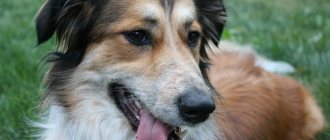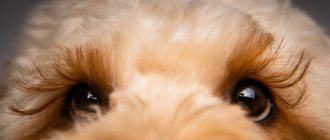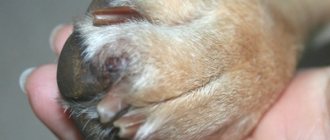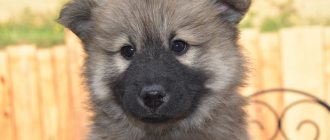Elem Rasulzhonovich Dzhumabaev
veterinarian at Petstory, specialization – oncology, soft tissue surgery
Unfortunately, dogs also have the same problem as acne. This problem is pathological and should be addressed by a veterinarian who monitors the dog’s health. It will be useful for owners to learn about the causes of acne in dogs, their types, and the measures that should be taken to prevent their occurrence.
Types of acne
The doctor decides what exactly to do to get rid of such dermal anomalies, but to do this he must diagnose the type of disease. The existing veterinary classification distinguishes several categories of such neoplasms:
- By nature of origin
- primary and secondary types. Primary acne is a disease in itself, secondary acne is a consequence of other diseases, complications after them;
- By localization
- Most often in dogs, acne occurs on the face, chin, lip, body along the body, on the head;
- By pigmentation
- with a reddish or white tint, with yellow or black splashes;
- According to the intensity of the lesion
- focal or extensive over the skin throughout the body;
- By number
- single and multiple;
- According to etiological characteristics
- non-contagious, allergic, nutritional, inflammatory or infectious in nature.
In addition, they come with different signs, which forms a symptomatic picture. When pimples appear in an animal, the following pathological manifestations may occur:
- Itching;
- Soreness;
- Bleeding;
- Redness;
- Swelling.
Depending on the nature of the origin, these symptoms may be supplemented by decreased appetite, increased body temperature, general weakness, anxiety and irritability, lethargy and constant scratching on the body.
In the classification of veterinary medicine, each pimple is designated by a specific term, often by the name of the disease. This is how dog acne, allergenic rashes, as well as the following varieties got their names:
- Cystic acne;
- Comedones;
- Papules;
- Acne in dogs;
- Microcomedones;
- Pustules.
Only a qualified veterinarian with experience in treating dermatological diseases of any origin can correctly identify one of the varieties of such neoplasms on a dog’s body. This is justified by the fact that it is impossible to establish an accurate diagnosis at home. In addition, differential diagnosis will be required due to the fact that the symptoms of many of these acne have a similar clinical picture.
Flea infestation
Symptoms:
- The dog is constantly itching, all over, here and there. The scratch is very characteristic: fast and furious.
- The animal sleeps poorly and nervously wanders around the apartment in search of relief from the unbearable itching. The dog becomes irritable and restless.
- A characteristic sign of a dog being infected with fleas: the pet begins to sharply bite into the skin, clattering its teeth, trying to catch the irritant.
- In advanced cases, the dog may develop an allergy to fleas. The eyes begin to water, the skin becomes covered with a rash, small blisters and pustules that burst and form ulcers and scabs. The animal can scratch such formations until there are bloody wounds and bald patches.
- If treatment is not started in time, fleas will lay eggs in the animal’s fur. They can be easily seen. But in this case, dogs with dark colors, so to speak, find themselves in a more advantageous situation. The fact is that flea eggs are light grains, in appearance somewhat reminiscent of grains of rice, only much smaller. The size of the eggs does not exceed one millimeter.
- If you run your hand over a dog’s fur, then in addition to fleas, larvae and eggs quickly hiding and escaping in the undercoat, you can see dark grains (parasite feces) on the animal’s fur.
- If it is difficult for the owner of a four-legged dog to determine whether his pet has fleas, then the best way to identify insects is to run a bath of water and bathe the dog. Upon contact with water, fleas will begin to move onto the animal’s head or jump into the water.
Treatment:
1. Bathe the animal with flea shampoo.
2. Sanitize the pet’s bedding and the entire room.
Prevention:
- Drops against fleas.
— Antiparasitic collar. ===================================================== ===================================================== ===================================================== =====================================================
Causes of acne
How exactly to treat acne on a dog’s stomach depends not only on the symptoms and clinical signs, medical history and condition of the animal. In the selection of treatment methods, the etiological factor—the causes of the disease—plays an important role. Acne can occur due to the following circumstances and factors:
- Attack of ectoparasites: lice, flies, mosquitoes, other insects;
- Attack of ticks, especially subcutaneous ticks, resulting in diseases such as demodicosis, sarcoptic mange;
- Infection with fungal pathogens that provoke the disease lichen;
- Negative effects of environmental factors: pollution, radiation exposure, solar radiation;
- The influence of toxic components contained in the air, food, care products;
- Exposure to allergens present in plant pollen, polluted water bodies, and air;
- Reaction to excess or lack of necessary ingredients in the dog’s diet;
- Reaction to sudden changes in temperature;
- Disruption of metabolic processes in the animal’s body at the cellular level or in tissues.
However, a common cause of the appearance of such rashes on the back or on the nose and lip can be an overdose of medications during treatment, frequent hypothermia, the consequences of certain viral diseases or the action of pathogenic bacteria.
Ticks
Pimples on a dog's face can appear due to tick infestation. There are two types of parasitic diseases most often found in domestic animals:
- demodicosis;
- sarcoptic mange.
Demodicosis is a disease caused by the demodex mite. This parasite lives under the skin in the hair follicles. Often the disease begins with the appearance of pimples on the dog’s lips. Then all other parts of the animal’s face and body become covered with small red acne, which are very itchy. The pet itches often. Bacteria often get into scratches, which leads to the appearance of pustules. Demodicosis is often accompanied by noticeable hair loss.
Another common parasitic pathology is sarcoptic mange. The causative agent of the disease is the scabies mite. This microscopic parasite gnaws holes in the skin, which is accompanied by severe inflammation and irritation. The dog's skin turns red and becomes covered with small pimples. The pet suffers from severe itching. Often dogs with sarcoptic mange literally tear their skin with their claws. On the pet's face and body you can notice bald areas, as well as numerous scratches covered with crust.
Acne in puppies
Unlike adults, pimples on a puppy’s belly can occur without pathological causes. They can result from the effects of drafts on an unstable organism. Frequent acts of urination before the age of 4-5 months lead to the fact that the litter does not have time to change and pathogens appear in a humid environment, causing irritation of the epidermis.
As we grow older, the hormonal system develops, age-related changes in which lead to the formation of acne.
The transition to new food products and changes in living conditions during this period can also cause rashes on different parts of the body.
Hurry up, choose a box and find out what gift awaits you
Discount on pet insurance
Promo code copied to clipboard
How to get rid of rashes
It is almost impossible to independently determine the cause of deterioration of an animal’s skin condition. You need to take your pet to the veterinarian as soon as possible. The specialist will prescribe all the necessary diagnostic tests and tests. Treatment will depend on the diagnosis.
In most cases, treatment with external ointments and gels is sufficient. Their choice depends on the cause of the rash. For pyoderma, antibacterial agents are indicated, and for lichen, antifungal agents. Antibiotic-based ointments are also prescribed for scratching the skin and the appearance of pustules. In case of severe pyoderma and lichen, these drugs are also prescribed in the form of tablets for internal use.
Under no circumstances should you try to squeeze out pimples. Before contacting a specialist, you can only treat acne with iodine or brilliant green, and also wash the affected areas with a decoction of chamomile or calendula. Human ointments should not be used on dogs. After all, animals require a much lower concentration of medicinal substances.
For demodicosis and sarcoptic mange, anti-mite shampoos and drops are used. The affected areas are treated with ointments based on ichthyol and sulfur. In case of severe infestation, acaricidal tablets and injections are indicated.
If acne is caused by allergies, then it is necessary to protect your pet from contact with irritating substances, and also review the dog’s diet. To relieve inflammation and itching, antihistamine ointments and tablets are prescribed.
Acne treatment
The course of therapy is prescribed based on the cause of the disease. You should not squeeze out pimples yourself - this can provoke secondary infections, aggravate the course of the disease and cause even more discomfort to the pet in the back, face or lips.
At the consultation, the veterinarian, after diagnosis using scrapings, washings, scatological and other studies, will select the necessary medications. For example, for acne of an allergic nature, antihistamines will be prescribed. For diseases with bacterial rashes, antimicrobial medications are indicated. External use products are prescribed for diseases caused by dietary disorders.
Along with drug therapy, it is necessary to adhere to the veterinarian’s recommendations for feeding and diet.
If your dog has pimples and itches, numbing ointments and creams can be used to help ease the discomfort and pain caused by scratching.
High-risk groups: which dogs get sick more often?
Some of the most acne-prone breeds are the pug and the beagle.
Some dog breeds, due to the characteristics of their biological structure, are more genetically predisposed to developing acne than others:
- with “wrinkled” skin - Shar-Pei, English Bulldogs, Pugs, Neapolitan Mastiffs (Mastino Neapoletano), Bullmastiffs, Basset Hounds, Dogues de Bordeaux;
- with webbed feet - Newfoundlands, Landseers, Portuguese Wasserhunds (Can-Diagua), Weimar pointers (Weimaraners), Otterhounds, Chesapeake Bay retrievers, German shorthaired pointers (shorthaired pointers);
- with smooth hair (smooth-haired) - dachshunds, toy terriers, Italian greyhounds, English greyhounds (greyhounds), pointers, bull terriers, Argentinean (Dogo-Argentino) and Great Danes, Dobermans, boxers;
- with residual fur (hairless) - Peruvian Inca dogs (viringo, calato), Chinese crested, Mexican hairless (xoloitzcuintle, xolo), American hairless terriers;
- with thick undercoat - Scottish (collie) and Caucasian shepherd dogs, Pekingese, chow-chow, Spitz, Samoyed huskies (Samoyeds), Bernese Mountain dogs, Tibetan mastiffs.
In the case of dogs with a very dense undercoat, the relevance of the concerns directly depends on the conditions of their keeping: if they constantly live in a hot, windless climate, then it is almost impossible to avoid the occurrence of inflammation.
Video - Skin diseases in dogs
Important! In male dogs castrated at an early age, the risk of developing “adult” acne increases many times over.
In outbred dogs (mongrels and mixed breeds), even when kept outdoors (in a kennel or enclosure), acne is extremely rare.
Bacterial skin diseases in dogs with symptoms and photos
Bacterial infections are not only secondary, but also primary. Most often they are provoked by streptococci and staphylococci, which enter the body through minor injuries. For effective treatment, you need to know the exact type of pathogen, since prolonged treatment with broad-spectrum antibiotics greatly weakens the body.
Streptococci
Most often, these bacteria cause folliculitis. It is accompanied by the formation of red spots or nodules around the hairs. Over time, the formations are filled with yellowish-green pus, and their opening when scratching leads to severe peeling and hair loss.
Staphylococcus
The most dangerous representative is Staphylococcus aureus. It is easily distinguished by frequent vomiting and diarrhea, which quickly dehydrate the body.
Without timely help, bacteria spread through the bloodstream, increasing the affected area. In addition to numerous boils and erosions, infection with staphylococci is fraught with inflammation in the ears, vaginitis, endometritis and pyometra.
Allergies and urticaria
Allergies are caused by common house dust, pollen, dog shampoo, food, tobacco or mold. Symptoms of the disease are individual for each pet. Some people are limited to a runny nose and red eyes, while others suffer from unbearable itching and rashes.
Hives are a type of allergic reaction. It is characterized by the appearance of round or oval plaques, as well as redness and thickening of certain areas of the body. These formations are very reminiscent of a burn after close contact with nettles.
The most dangerous manifestation of allergies is Quincke's edema. It is accompanied by extensive swelling, an attack of suffocation, and pale or blue discoloration of the mucous membranes. Without timely assistance, the animal risks dying, so it must be taken to a doctor immediately.
Fungal skin diseases in dogs with photos and descriptions
An alternative name for this group is dermatomycosis. Their causative agents are molds and yeasts.
Trichophytosis
Trichophytosis, or ringworm, is transmitted to humans. To avoid infection when treating a patient, it is recommended to use personal protective equipment.
Fungi are concentrated at the base of the tail, knees, elbows, top of the skull and the area between the ears. As a result of their vital activity, the epidermis becomes inflamed and loosens. The hair on the affected areas begins to fall out, and the skin becomes red and hot. Over time, asymmetrical bald spots appear on the body, covered with gray scabs. When they are scratched, pus bursts out of the wounds.
Microsporia
This disease is less dangerous, since it does not cause complications to internal organs. Also, fungi of the genus Microsporum canis do not reproduce on human skin. They can be seen using an ultraviolet lamp. Under its light they turn green.
As a result of infection, the dog's claws peel and turn yellow, and the paw pads become rough and flaky. All affected areas become very itchy and bald, but no inflammatory reaction occurs.











